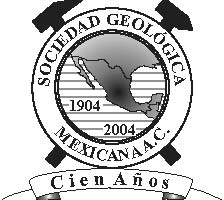|
BOLETÍN DE LA SOCIEDAD GEOLÓGICA MEXICANA VOL. 59, NÚM:. 1, 2007, p. 83-99 http://dx.doi.org/10.18268/BSGM2007v59n1a7 |
 |
Disolución y precipitación de carbonatos en sistemas hidrotermales. Implicaciones en la génesis de depósitos tipo MVT
Mercè Corbella1,*, Esteve Cardellach1, Carlos Ayora2
1 Departament de Geologia, Facultat de Ciències, Universitat Autònoma de Barcelona, 08193-Bellaterra, Cataluña, España.
2 Institut de Ciències de la Terra Jaume Almera, Consejo Superior de Investigaciones Científicas, c/ Martí i Franquès s/n, 08028-Barcelona, Cataluña, España.
* This email address is being protected from spambots. You need JavaScript enabled to view it.
Abstract
The formation of secondary porosity in deep carbonates as observed in hydrocarbon reservoirs or Zn-Pb Mississippi Valley type (MVT) deposits is difficult to explain as kinetic and thermodynamic data suggest that low temperatures hydrothermal solutions flowing through carbonate rocks are in equilibrium with them and dissolution cannot occur. Textural studies in MVT deposits provide the clue to the paradox. Some textures indicate that dissolution of the carbonate host rock was concomitant with sulfide, sulfate and carbonate porosity filling; however, other textures point to a rapid growth of crystals in open spaces. The mixing of two hydrothermal solutions conciliates the observational features with experimental and theoretical data. Numerical methods used to perform the calculations of reactive transport in the context of MVT ore formation show that mixing between an acidic brine with dilute and alkaline groundwater, both independently saturated with respect to carbonate forms with an intermediate chemistry but mostly undersaturated with respect to carbonate. Therefore, the mixture is carbonate-corrosive and is able to build cavities within a time span of some tens of thousands of years. Sulfides precipitate surrounding cavity walls when the mixing fluids carry metals and sulfur; this reaction is concomitant with an increase in porosity. Such porosity is not large enough to explain the developed cavity but is sufficient to prevent its armoring by sulfides. Sulfate may precipitate in the open spaces formed whenever the sulfur-rich fluid carries more sulfate than sulfide (a slightly oxidizing fluid). Mixing of different proportions of end-member fluids results in cavities of uneven shapes, as cavities tend to enlarge towards the smaller flux direction. From the textural and reactive transport study in MVTs we conclude that cavity formation, sulfide precipitation and sulfate filling may be generated by the same major process of hydrothermal fluid mixing.
Keywords: MVT textures, carbonate dissolution, hydrothermal karst, numerical simulations, reactive transport.

